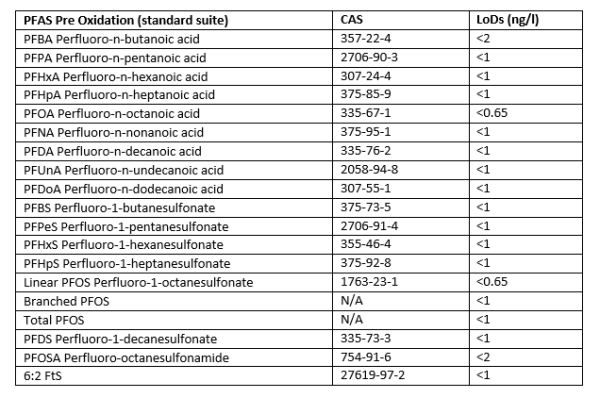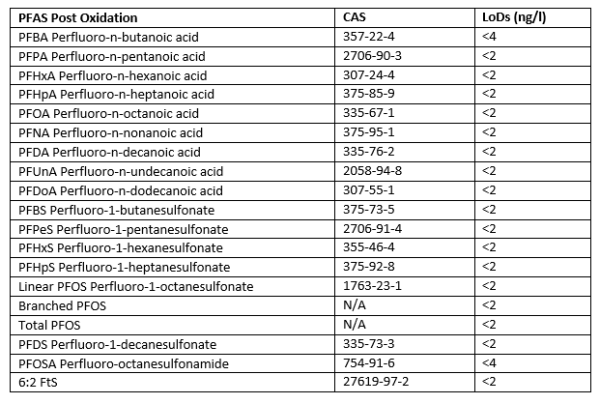ALS Leading the Industry in the Analysis of Per- and Polyfluoroalkyl Substances (PFAS)
Jun 11, 2020
Our understanding of the presence, toxicity and potential effects of this group of emerging contaminants continues to advance. Although PFAS have been used for decades, only recently, due to advances in laboratory techniques, has it been possible to reliably quantify their presence and potential impacts.
ALS has vast experience in working with environmental consultants and remediation contractors throughout the world. The assessment of PFAS presents specific and unique challenges, it is therefore essential to partner with a laboratory with experience in analysing such samples to ensure sites are properly characterised using the most advanced analytical techniques available.

PFAS – the analytical challenges
PFAS are challenging contaminants because most constituents cannot be detected by conventional analytical techniques. The sources of PFAS in the environment, such as Aqueous Film Forming Foam (AFFF), involve complex mixtures of individual PFAS constituents. Assessment of sites impacted by PFAS require decisions to be made on the most robust, accurate and reliable data.
PFOS (perfluorooctane sulfonic acid) and PFOA (perfluorooctanoic acid), termed long-chain PFAS, are the best known examples and have been the focus of regulatory attention. Their potential impact on human health has been recognised globally as they are extremely persistent, bioaccumulative and toxic. More recently, concern has extended to a much wider number of the PFAS including short-chain PFAS that are generally more soluble and mobile in groundwater.
Conventional methods allow for the analysis of around 15-20 different compounds. There are, however, many more PFAS which will be left undetermined including a significant number of polyfluoroalkyl substances. Under specific conditions in the environment, these compounds can be converted into perfluoroalkyl acids (PFAA). Several common PFAA precursors containing a C8-perfluoroalkyl chain, including C8 sulphonamide compounds and 8:2 fluorotelomer alcohols, have been shown to partially transform to PFOA. The behaviour of PFAS can vary depending, not only on the composition of the mixture, but also on the presence of co-contaminants and the impact of remediation induced changes in the subsurface. As a result, there are significant analytical challenges to overcome when considering how to assess soil and groundwater. The failure to detect this hidden mass of precursors has led to increased uncertainty leaving sites with future residual liabilities. A new innovative approach was needed.
TOP Assay – a significant step forward
Total Oxidisable Precursor (TOP) Assay is a more comprehensive analysis technique and represents a significant step forward in the assessment of PFAS. It converts precursors in a sample which are detectable by liquid chromatography with tandem mass spectrometry (LC-MS/MS). Results are provided both pre and post digest, at a limit of detection (LoD) of around 2 ng/l. The method removes the proprietary part of the molecule, using oxidative conditions, this results in the generation of PFAA which are used as a measure of the presence of the precursors. TOP Assay also provides indicative data regarding the perfluoroalkyl chain length of the precursors, which can assist with assessing the source of the PFAS contamination and their potential to bioaccumulate.
Summary
In terms of investigation and remediation of sites impacted by PFAS, the approach taken is often different to conventional contaminants in view of the large number of compounds, precursors and breakdown products as well as the complex source compositions and fate and transport characteristics.
TOP Assay provides a pragmatic and cost-effective solution to assessment of risks from PFAS. Increasing consideration of PFAS chemistry and precursor loading will be needed in the future to better assess PFAS impacted sites.
PFAS TOP Assay Analytes

Branched and linear isomers of PFOS need to be determined. If these are not reported, the results might be underestimating PFOS concentrations by 20-30% depending on the original manufacturing process. The presence of linear and branched isomers also have implications for partitioning, transport and bioaccumulation.

Analysis of soils can be carried out by TOP Assay. For further information contact our client services team: hawardencustomerservices@alsglobal.com or 01244 528777.
References
- Buck, R.C., Franklin, J., Berger, U., Conder, J. M., Cousins, I. T., de Voogt, P., Jensen, A. A., Kannan, K., Mabury, S. A., van Leeuwen, S. P. 2011. Perfluoroalkyl and polyfluoroalkyl substances in the environment: terminology, classification, and origins. Integrated Environmental Assessment Management. 7(4): 513-41.
- Interstate Technology & Regulatory Council - Technical/Regulatory Guidance Per- and Polyfluoroalkyl Substances (PFAS) ITRC 2020.
- Ross, I., Hurst, J., 2019. Managing Risks and Liabilities associated with Per- and Polyfluoroalkyl Substances (PFASs). CL:AIRE Technical Bulletin TB19. CL:AIRE, London, UK
- Simon J.A., Abrams S., Bradburne T., et al. PFAS Experts Symposium: Statements on regulatory policy, chemistry and analytics, toxicology, transport/fate, and remediation for per‐and polyfluoroalkyl substances (PFAS) contamination issues. Remediation. 2019; 29:31–48


